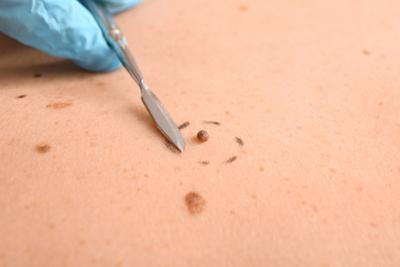
Moles on the skin are quite common and most adults have at least a few on their body. Moles are usually harmless, but there is a possibility that they could become cancerous so it is important to have a dermatologist examine them once a year. Dr. Robert C. Griffith and Dr. Robert D. Griffith, the board-certified dermatologists at Griffith Dermatology in Knoxville, TN, screen moles for signs of skin cancer and perform removal when needed.
What Are Moles?
Moles are also called nevi and are pigmented growths on the skin’s surface. They are usually brown or black in color, and round or oval in shape. Moles can be flat or raised with a smooth or rough texture.
A mole is actually a cluster of cells called melanocytes. These cells are responsible for the skin’s pigmentation. Most melanocyte cells are spread out across the skin, but when some of these cells grow close together in a cluster they form a mole.
How Do Moles Develop Cancer?
Most of the time moles are benign and do not develop cancer. However, certain factors do increase the risk of a mole developing a type of skin cancer called melanoma. Extensive exposure to ultraviolet (UV) light either from the sun or tanning beds increases the risk of a mole becoming cancerous. Individuals with 50 or more moles also have a higher risk of developing melanoma.
When Should a Mole Be Removed?
A mole can be removed for several reasons, including personal preference or to reduce the risk of developing skin cancer. Some individuals choose to have a mole removed for aesthetic reasons, often because they do not like where it is located or how it looks.
Other moles can be bothersome, especially raised moles that become irritated when clothing rubs against them. Some people have these removed for comfort. A dermatologist can usually remove unwanted or bothersome moles even if they are benign.
Moles with a high risk of developing melanoma or that show signs of cancer should be removed. The skilled dermatologists at our office in Knoxville, TN, can determine which moles should be removed to reduce your risk for melanoma. Some warning signs that a mole might be malignant include:
- The mole is asymmetrical with one half being unlike the other.
- An irregular border that is scalloped or poorly defined.
- There is not a consistent color throughout; the color varies from one area to another.
- The mole is large in size with a diameter bigger than 6mm.
- The size, shape, or color of the mole changes with time.
How Are Moles Removed?
There are several methods for safely removing unwanted or suspicious moles from the skin. One method is surgical excision in which the mole is cut out and the skin is stitched closed afterward. This method is often used to remove cancerous moles.
Other mole removal methods include freezing, burning, and shaving. These methods are frequently used to remove benign moles. Freezing involves the use of liquid nitrogen to freeze the mole. Burning utilizes an electric current to burn off the upper layers of the mole. With shaving, the mole is carefully shaved off with a surgical blade. The doctor can determine which method is needed based on the reason for removal and other factors.
Moles are usually nothing to worry about but should be removed if they pose a high risk of becoming cancerous. Schedule a skin cancer screening with one of our experienced dermatologists Dr. Robert C. Griffith and Dr. Robert D. Griffith to find out if you need the removal of certain moles by calling Griffith Dermatology in Knoxville, TN, at (865) 588-1361.
